NIL
Name
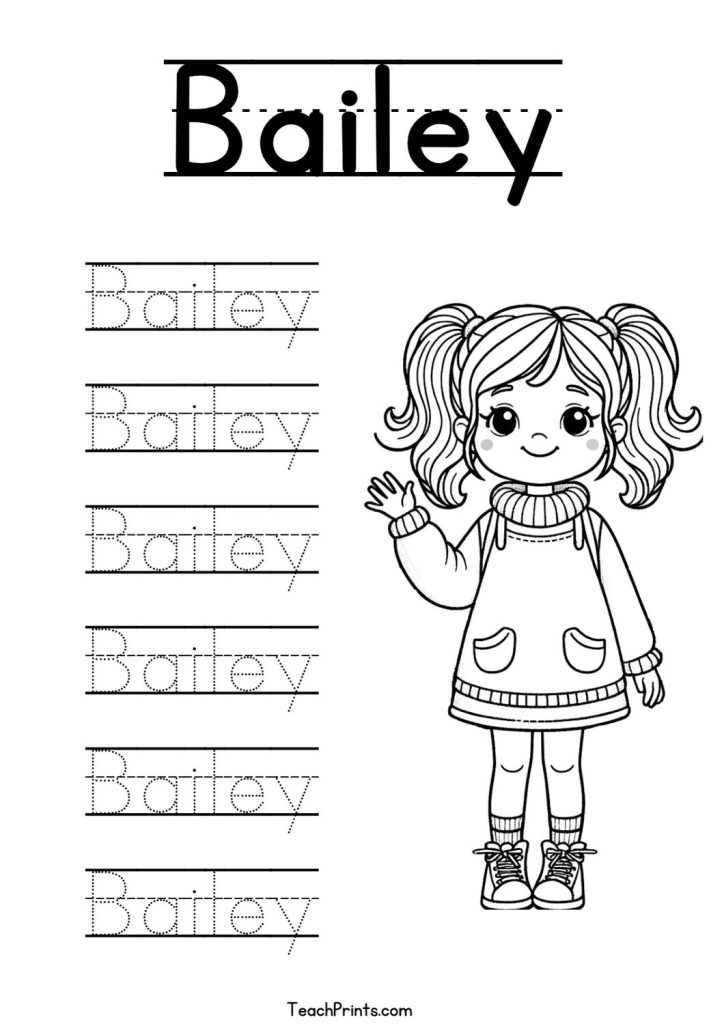

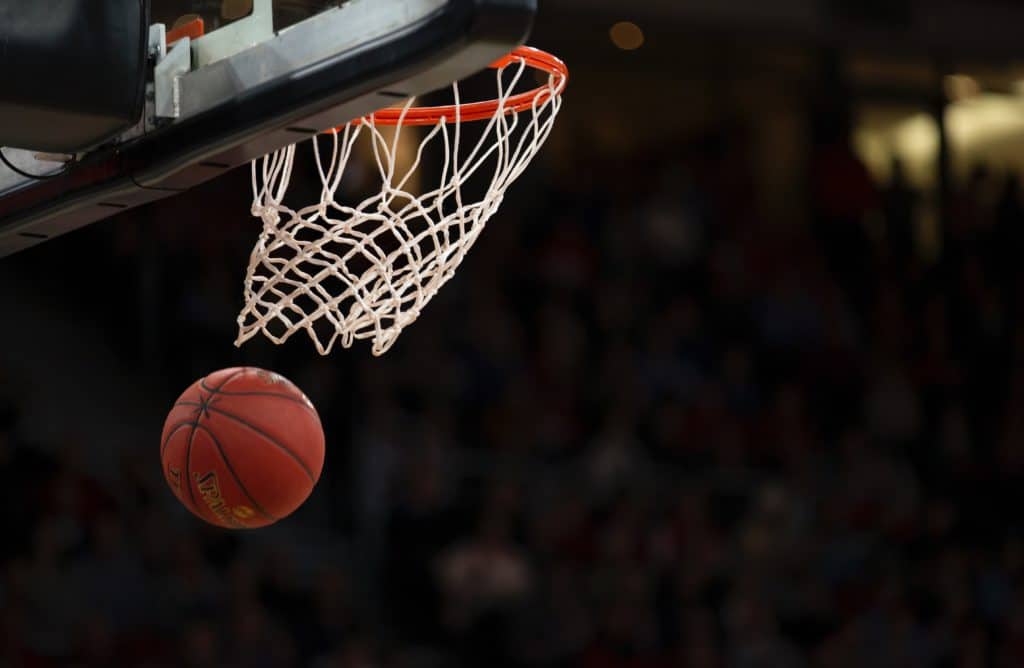
For years, it’s been hard not to feel at least a little guilty watching March Madness. The annual college basketball tournament generates over a billion dollars. Schools, coaches, advertisers, and tv networks make money hand over fist. Yet, one group was always left out in the cold: the players.
Despite the obvious profit motive of the entire enterprise—from massive ad campaigns to widespread gambling on the games—the NCAA insisted on preserving the amateurism of the “student athletes” by preventing them from cashing in at all.
In 2021, the Supreme Court’s decision in NCAA v. Alston changed all of that. Suddenly, college athletes were allowed to profit off of their name, image, and likeness or “NIL.” Combined with post-COVID changes to student transfer eligibility rules and increased conference realignment, NIL has dramatically reshaped the landscape of bigtime college athletics. The NCAA’s sanctimonious insistence on the purity of sport without money has given way to a widespread acknowledgement that bigtime college athletics is a mercenary enterprise.
For many of us who criticized the NCAA and have called for players to be paid and receive workplace protections, the last few years have brought positive developments (and allowed for some guilt-free sports watching). But, the NIL era raises some troubling questions.
There’s much to be said about whether college sports can (or should) survive the NIL revolution and about equity in the NIL landscape across schools, sports, genders, etc.
More broadly, though, the rise of the NIL market provides a window into a concerning trend in how labor is commodified. The NIL framework means that athletes aren’t paid directly for playing sports—the activity that generates value, that requires tremendous skill, and that defines their role in society. Instead, the athletes are technically paid for advertising, for content creation, and—above all—for being celebrities.
It may be that more successful athletes on the court or field will make more money off the court or field. But that’s not necessarily true. Perhaps the most notable example here is Louisiana State University gymnast Livvy Dunne, who parlayed unremarkable performances at meets into NIL-era fortune and fame as an Instagram model and influencer.
Of course, a certain number of the NIL payments are “NIL” in name only. Many NIL deals are a legal version of what most observers long suspected was going on in bigtime college sports: athletes receiving under-the-table payments and gifts from boosters (ostensibly without the knowledge of coaches or universities). In those bad old days, players weren’t getting paychecks for their performance, but that didn’t mean that they weren’t getting paid. The current NIL system might not be so different. Players aren’t on the university payroll. Instead, NIL collectives arrange deals for players. The NIL money is used in recruiting and as a means of fielding high-priced teams full of blue-chip prospects.
Nevertheless, athletes still can’t be paid for being athletes. They can be paid for being advertisers (or being advertised).
To be clear, I don’t mean to suggest that many of the off-court activities that college athletes engage in aren’t “work.” Rather, I think it’s important to recognize that the work that is technically being rewarded involves building a brand.
There’s something striking about the NIL framing and the fact that the framework and language continues to insist that the basis for compensation can’t actually be the athletic work itself. What makes Big Time college athletics such big business is the performance on the field or the court. But, the NIL regime refuses to commodify or compensate for the actual valuable commodity.
The NIL regime, then, illustrates a broader cultural and economic phenomenon.
In a post-industrial internet age, the tech entrepreneur and the app inventor became models for success in US society. And, as social media use has exploded, the influencer economy has taken hold. At the same time, we’ve seen the rise and entrenchment of the so-called gig or sharing economy.
In each of these contexts, people are doing work. But what’s celebrated or identified as central to the enterprise is something entrepreneurial. We all are our own business owners. We are all our own promoters. On social media, each of us is essentially our own agent, publicist, or press secretary—posting our own ads, statements of purpose, or press releases and trying to frame, or sell, or “curate” our image.
The NIL framework reflects a similar dynamic.
Presented with the obvious injustice of a multi-billion-dollar industry where the workers got nothing, the response was to allow for payment but to continue to devalue the work itself. It’s an approach consistent with a sort of post-postindustrial labor economy: the market isn’t in the direct goods or services that a worker provides; it’s in the worker’s ability to market.
To the extent that the professionalization of bigtime college athletics is here to stay, the next step should be figuring out a new framework for compensating and regulating the actual athletic labor. Thankfully, there are any number of professional sports leagues—and professional players associations’ collective bargaining agreements—to look to for examples.
NIL
Notre Dame AD calls College Football Playoff rankings an ‘absolute joke’ after Irish CFP snub
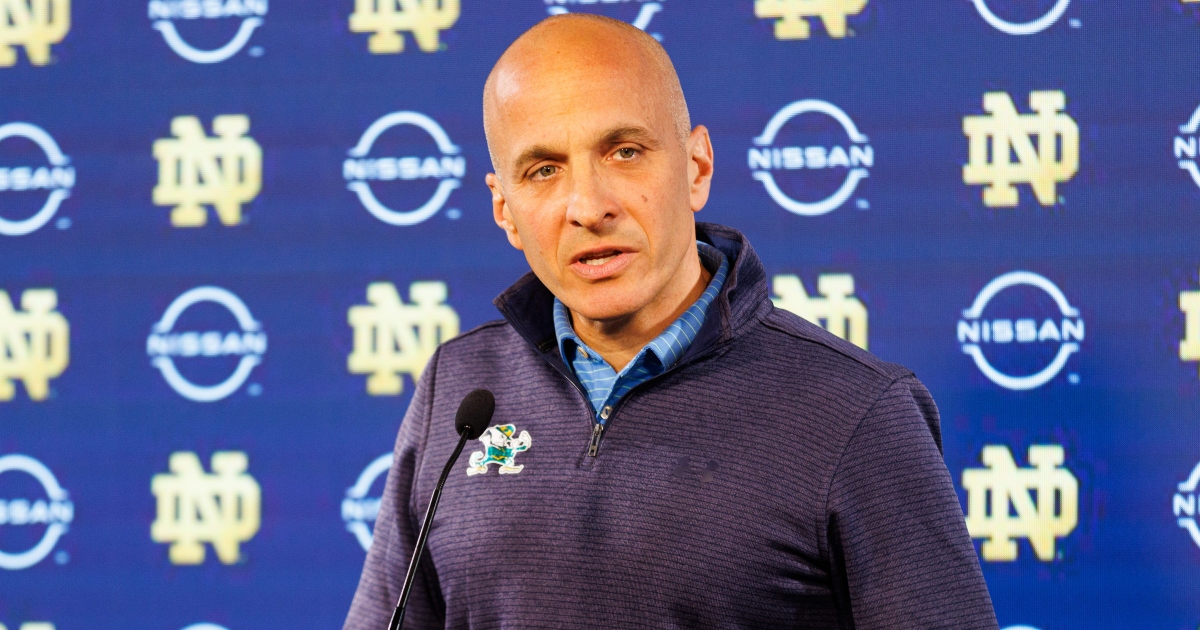
There was no way everyone was going to be happy with the final College Football Playoff rankings. In the wake of the conference championship games, it was clear that three teams, Notre Dame, Miami, and Alabama, were competing for two at-large spots. In the end, it was the Irish who got left out.
In the wake of that snub, Notre Dame athletic director Pete Bevacqua ripped the selection committee, calling the rankings an “absolute joke.” Further, he’d add that the program is shocked to be left as the First Team Out.
“My feelings and the feelings here are just shock and, really, an absolute sense of sadness for our student-athletes,” Pete Bevacqua told Yahoo Sports on Sunday. “Overwhelming shock and sadness. Like a collective feeling that we were all just punched in the stomach.”
Notre Dame had entered the weekend ranked ahead of Miami, despite losing to the Hurricanes in Week 1. At No. 10 and with the Hurricanes at No. 12, the Irish sat right on the cut line. That all changed over the weekend, as BYU lost, dropping them in the rankings. That led to a direct comparison between Notre Dame and Miami, which is when head-to-head finally became a factor. Meanwhile, Alabama lost over the weekend but didn’t slip from No. 9 at all.
For Notre Dame and Bevacqua, it was inexplicable. In fact, the College Football Playoff even feels stolen to them.
“There is no explanation that could possibly be given to explain the outcome,” Bevacqua said. “As I said to Marcus [Freeman], one thing is for sure: Any rankings or show prior to this last one is an absolute joke and a waste of time. Why put these young student-athletes through these false emotions just to pull the rug out from underneath them having not played a game in two weeks and then a group of people in a room shatter their dreams without explanation? We feel like the Playoff was stolen from our student-athletes.”
Hunter Yurachek, the chair of the selection committee, spoke on ESPN shortly after the rankings came out as well. There, he did his best to explain the decision-making process.
“The first move in that (decision-making process) was we felt like the way BYU performed in their (Big 12) championship game with a second loss to Texas Tech in a similar fashion was worthy of Miami moving of them in the rankings. And once we moved Miami ahead of BYU, then we had that side-by-side comparison that everybody has been hungering for with Notre Dame and Miami,” Yurachek said on ESPN.
“And when you looked at those teams on paper, they’re almost equal in their schedule strength, their common opponent, the results against their common opponent. But the one metric that we had to fall back on again was the head to head. I charged the committee members to go back and watch that game again, the Miami-Notre Dame game because it was so far back, and we got some interesting debate from our coaches on what that game looked like as they watched it. With that in mind, we gave Miami the nod over Notre Dame in that 10th spot.”
ESPN’s Rece Davis would counter, wondering why this was the first time head-to-head seemed to matter in this discussion. However, again, Yurachek explained it wasn’t discussed until BYU fell from No. 11, making them directly next to one another in the rankings. That process would seemingly become the issue that Davis took issue with. Given that Bevacqua feels the Playoff was stolen from Notre Dame, it appears that frustration isn’t unique to him.
Bevacqua would go on to explain to ESPN that there is frustration with the process. On top of that, they’ve not yet considered what their bowl future is going to look like.
NIL
Maybe NIL is not the reason for Kentucky basketball’s woes
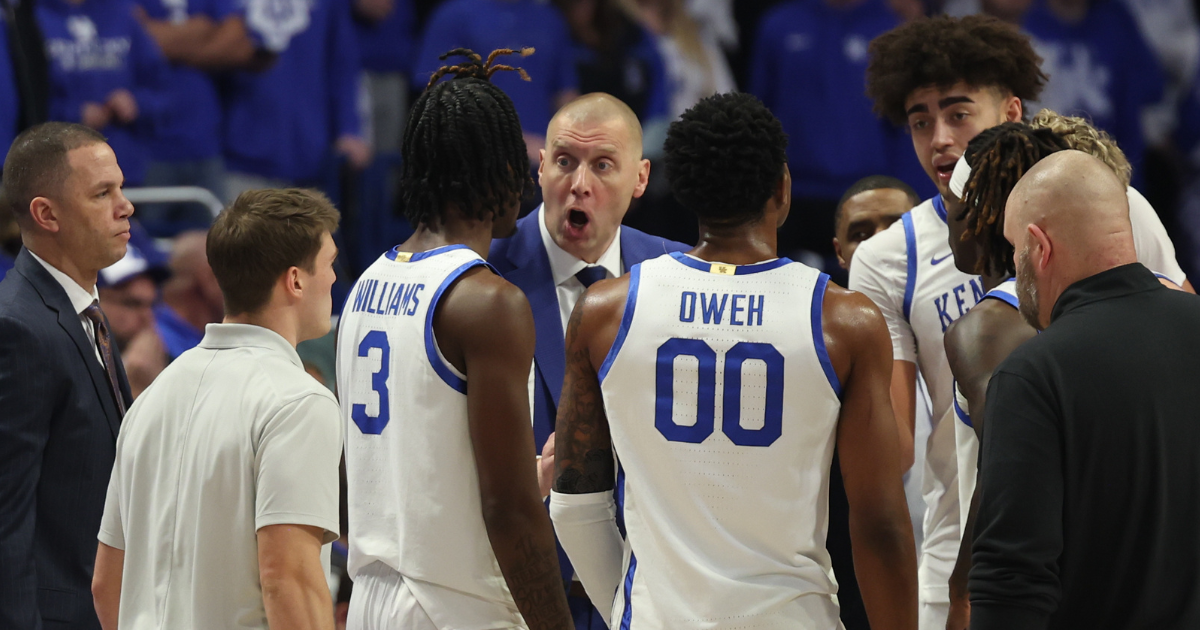
It is easy to point to big NIL deals as an excuse for why Kentucky players don’t appear to be fully invested in the effort department as of late. I know I’m certainly guilty of it. Kentucky’s extremely high payroll is low-hanging fruit as to why this team looks like it would rather be doing anything else than playing basketball with each other.
After every embarrassing loss (the likes of which keep piling up), the term “$22 million!” gets thrown around not only from fans of opposing teams mocking Kentucky, but also from within Big Blue Nation, embarrassed that this staff appears to have totally botched their epically large piggy bank.
However, I’m not talking about the roster construction aspect of NIL frustration. Assembling basketball pieces that don’t fit is its own gigantic problem, but oftentimes, fans place blame on players’ paychecks for their lack of hustle.
The argument goes something like, “Why would that player dive on the ball for a loose ball when they are being paid a couple of million dollars?”
But the money is far from the issue.
It ain’t about the money
As Jessie J says, it’s not about the money. Former Kentucky backup point guard Shai Gilgeous-Alexander signed a $285 million dollar contract this summer, a number far exceeding anything these Kentucky players (or most humans) will ever see, and that doesn’t stop him from playing hard every night and leading his team to an NBA record-setting 22-1 start.
But even if you dismiss this hyperbolic analogy and call it an unfair comparison to liken college role guys to one of the biggest stars on the planet, look at any of the many other transfer portal rent-a-players and elite freshmen who are getting paid big bucks. Take your pick. Most of them don’t seem to be having a problem leaving it all on the line every night and winning along the way.
If this were the issue, what is the fix for this? Pay less? If a player only gets paid $500,000 instead of $1,000,000, is he going to be more motivated to hustle? To give effort? To show more pride in wearing the name Kentucky across his chest?
I don’t have that kind of money, but I don’t buy that argument. At some point, it’s not the money. It is the personalities to whom you gave the money in the first place.
Oh, and coaching too
The blame doesn’t stop with the players. There is clearly a disconnect between the coaching staff and the group of guys they handpicked to wear the Kentucky jersey. Mark Pope makes more than twice as much money as any particular player, and while it is impossible to judge effort as he stands stoically, arms crossed, on the sidelines, his post-game press conferences would suggest he cares deeply. However, he also seems lost on how to motivate his team to care.
Money doesn’t factor into poor coaching just like it doesn’t factor into poor play. However, it would be that expectations and promises associated with money do.
Mark Pope’s relentless positivity is one of his more endearing traits, but is it possible his sunshine-pumping is coming back to haunt him? Everyone spun the fact that Kentucky’s roster was 12-plus players deep as a good problem to have, but if you tell each one of them about how big a role they will play and compensate them accordingly, promises will inevitably be broken.
It’s just math. There are only 200 minutes to be played in every basketball game. Kentucky averages 72 possessions per game. Not everyone can play 30 minutes and get up 10 shots. I’m not in the recruiting room with Mark Pope, so I can only speculate as to what he is promising recruits and portal transfers, but big money often comes with big player expectations, at least in players’ eyes, and when those expectations become incompatible with reality, egos get bruised and frustration kicks in.
Ultimately, this is all just an attempt to grasp at straws. Money, expectations, chemistry, personalities, coaching, whatever. Fans and (unfortunately) coaches are searching for answers, and as of now, there is one to be found.
NIL
Kirk Herbstreit calls for major change after College Football Playoff bracket set
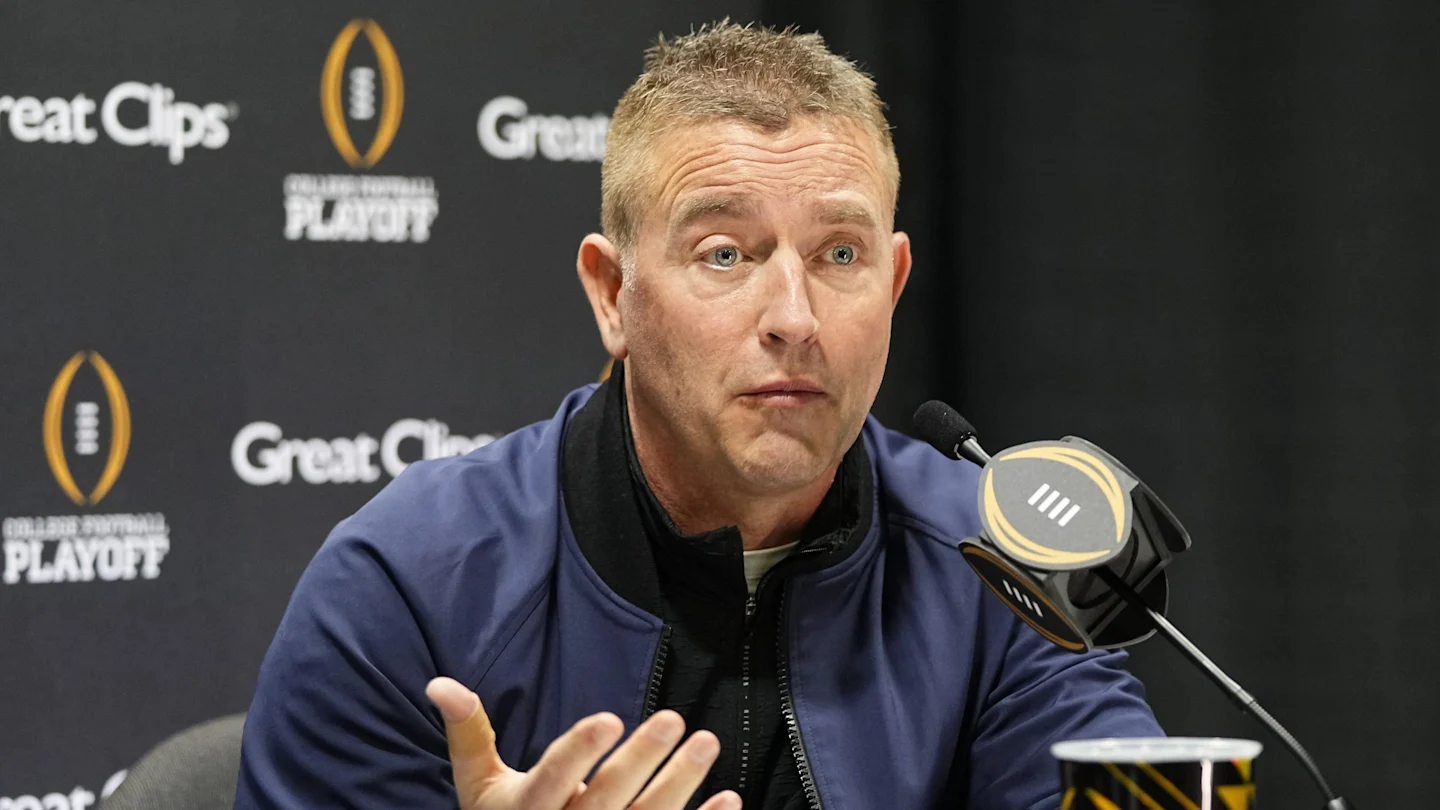
The College Football Playoff Selection Committee finalized the 12-team bracket on Sunday and unveiled the Indiana Hoosiers as the No. 1 overall seed. Indiana completed a perfect 13-0 season to secure the top ranking and a first-round bye alongside the Ohio State Buckeyes, Georgia Bulldogs and Texas Tech Red Raiders.
The reveal provided significant relief for the Alabama Crimson Tide and Miami Hurricanes. Both programs earned at-large bids despite recent stumbles. Alabama remained at No. 9 following a loss in the SEC Championship Game while Miami claimed the No. 10 seed after missing the ACC title game entirely.
The final selections resulted in a difficult outcome for the Notre Dame Fighting Irish. The committee designated Notre Dame as the first team out, ending its national title hopes despite a 10-2 record. Two Group of 5 conference champions joined the field as the Tulane Green Wave and James Madison Dukes earned the No. 11 and No. 12 seeds respectively. Tulane will face the Ole Miss Rebels in the first round while James Madison travels to play the Oregon Ducks. The remaining opening-round matchups feature Alabama visiting the Oklahoma Sooners and Miami traveling to face the Texas A&M Aggies.
The exclusion of Notre Dame immediately sparked conversation regarding the efficacy of the current 12-team model. The Fighting Irish won 10 consecutive games to close the regular season but lacked the automatic qualifier status that protected other contenders. This scenario led to instant calls for further expansion before the inaugural 12-team tournament even commenced. Prominent analysts shifted the focus from the specific teams selected to whether the format itself requires adjustment to ensure all deserving programs have a path to the championship.
Kirk Herbstreit Endorses Sixteen Team Format
Longtime ESPN analyst Kirk Herbstreit advocated for a 16-team postseason field shortly after the bracket announcement on Sunday. Herbstreit also appeared on The Pat McAfee Show last week and suggested that a larger format would eliminate political posturing and allow for a pure meritocracy.
He argued that the current system attempts to appease too many different groups rather than simply identifying the best squads. Herbstreit believes moving to 16 teams is the logical next step to solve the controversies that left a 10-win Notre Dame team on the outside looking in.
“It’d be great if we had 16 teams,” Herbstreit said. “Maybe that’s the next answer to get this thing up to 16 teams.”
Kirk Herbstreit: “It’d be great if we had 16 teams. Maybe that’s the next answer to get this thing up to 16 teams.”
— Ross Dellenger (@RossDellenger) December 7, 2025
The analyst emphasized that fans prioritize seeing the best competition over boardroom politics. His comments reflect a growing sentiment that the 12-team model still leaves room for subjective errors.
Notre Dame athletic director Pete Bevacqua shared this stance on Friday during The Pat McAfee Show, noting that there is nearly unanimous agreement among leaders to expand the field eventually. Bevacqua highlighted that a 16-team bracket would include five automatic qualifiers and 11 at-large bids. This structure would have likely secured a spot for the Irish.
The current field features intriguing matchups despite the controversy. The Tulane Green Wave will face Ole Miss in a contest defined by coaching changes. The Rebels enter the postseason with new head coach Pete Golding following the departure of Lane Kiffin.
Jon Sumrall will lead Tulane before he leaves for the Florida Gators. Meanwhile, the James Madison Dukes completed a rapid ascent from the FCS to FBS in 2022 to now earn a playoff berth against Oregon.

The first-round games are set to take place on campus sites. Higher seeds will host these contests before the scene shifts to traditional bowl venues for the quarterfinals. The winners of the opening round will advance to face the top four seeds who received byes. Indiana awaits the winner of Alabama and Oklahoma while Ohio State will play either Miami or Texas A&M.
The No. 12 seed James Madison Dukes will visit the No. 5 seed Oregon Ducks on Friday, Dec. 19.
Read more on College Football HQ
NIL
Urban Meyer firmly believes three-loss team should make College Football Playoff
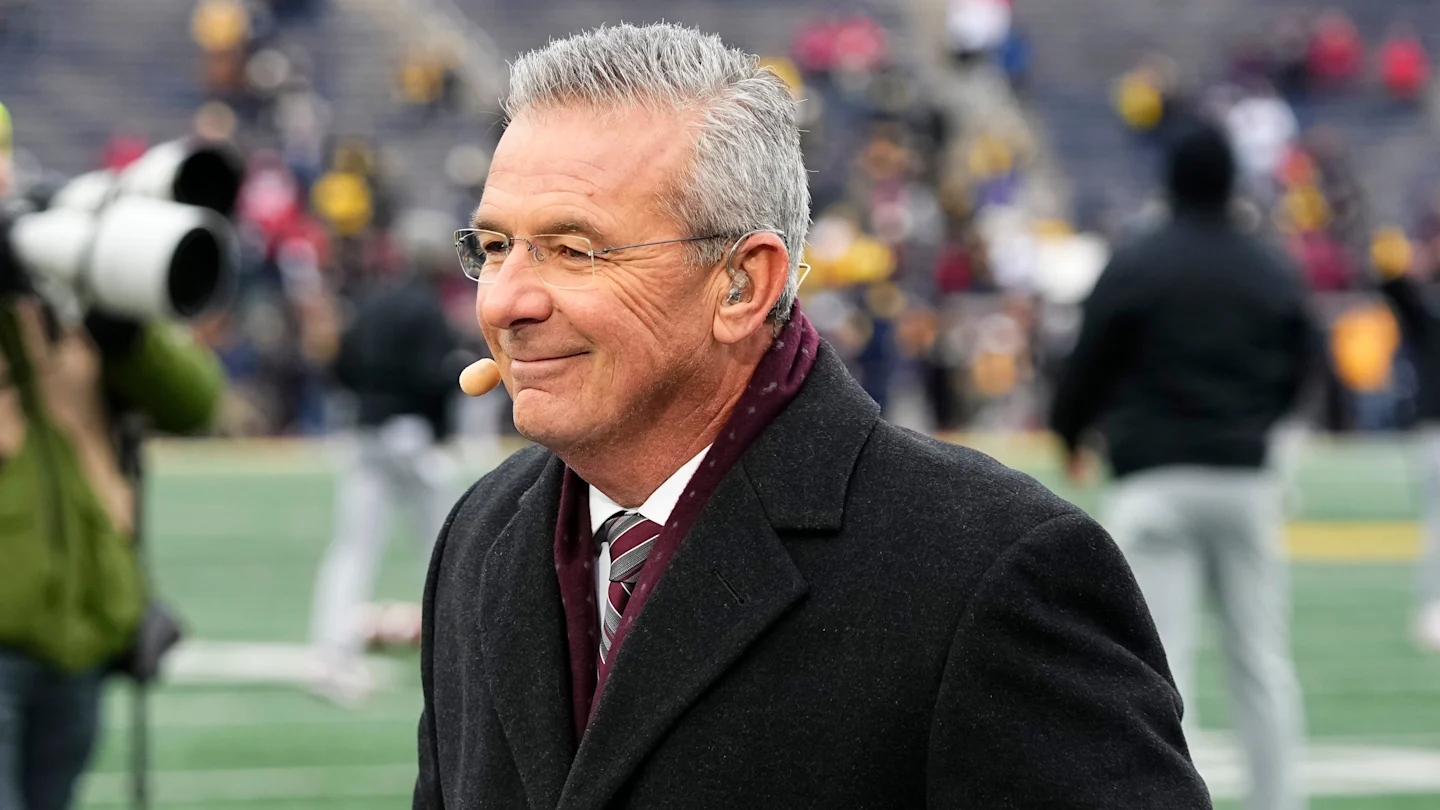
Alabama Crimson Tide playoff resume in question following loss to Georgia
The Georgia Bulldogs solidified a spot in the College Football Playoff with a decisive 28-7 victory over the Alabama Crimson Tide in the SEC Championship Game. Georgia quarterback Gunner Stockton earned MVP honors after he threw three touchdown passes and rushed for another 39 yards.
The result marked the first time the Bulldogs defeated the Crimson Tide in a conference title game under the current coaching regime. The loss left the Alabama offense searching for answers after the unit finished with minus-3 rushing yards.
Alabama Crimson Tide head coach Kalen DeBoer expressed concern regarding how the selection committee would view the blowout defeat. The program fell to 10-3 on the season and now sits on the bubble for the 12-team field.
DeBoer argued that reaching the SEC Championship Game should not negatively impact the resume of his team. He noted that the game provided a difficult additional data point that other contenders, like the Miami Hurricanes or Notre Dame Fighting Irish, did not have to navigate this weekend.
The debate surrounding the final at-large spots intensified immediately following the final whistle in Atlanta. Analysts questioned whether a three-loss team that was non-competitive in its final outing deserves a berth over teams with fewer losses.
The CFP committee must weigh the value of the difficult SEC schedule against the lack of offensive production shown on Saturday. The Crimson Tide entered the weekend ranked inside the top 10 but now face a nervous wait to see if their season will continue.
Urban Meyer Defends Alabama Playoff Resume
During the broadcast of the Big Ten Championship Game between the Indiana Hoosiers and Ohio State Buckeyes, a prominent voice emerged to support the Alabama case. Former Ohio State Buckeyes head coach Urban Meyer argued passionately that the committee should not punish the Crimson Tide. Meyer emphasized the difficulty of playing the Bulldogs in their home state during such a high-pressure matchup.
“You guys, you can’t penalize Bama for going to Georgia,” Meyer said at halftime of the Indiana vs. Ohio State Big Ten Championship Game. “It’s at Georgia, it’s in Atlanta. You play a great football team, you can’t do that. You set the precedent, you’re going to hear people say ‘Why go play in that championship game?’”

Meyer debated the topic with Fox Sports analyst Mark Ingram, a Crimson Tide alumnus. Ingram worried that his former team would be left out due to the nature of the loss. Meyer countered that penalizing a team for playing an extra game against an elite opponent creates a bad incentive structure for the sport. He, like former NFL coach Jon Gruden before him, suggested that the current system is flawed and calls for a significant overhaul to remove the subjective nature of the selection process.
“Get rid of the committee and have all play-in games,” Meyer said.

The former coach outlined a specific proposal that would guarantee spots for conference teams. He referenced a model created by Big Ten Commissioner Tony Pettiti.
“The committee’s got to go away. We’ve got to do a play-in,” Meyer said. “We’ve got to do, and Tony Pettiti, the commissioner of the Big Ten, came up with a 4-4-2-2-1-1 model, and that’s going to be the Big Ten gets four. One plays two, they’re both in. One gets a ring, one doesn’t.”
The Crimson Tide will find out if they’ve earned a berth in the playoff during the Selection Show on Sunday at noon ET on ESPN.
Read more on College Football HQ
NIL
College Football Playoff Rankings Just Shook the National Championship Odds
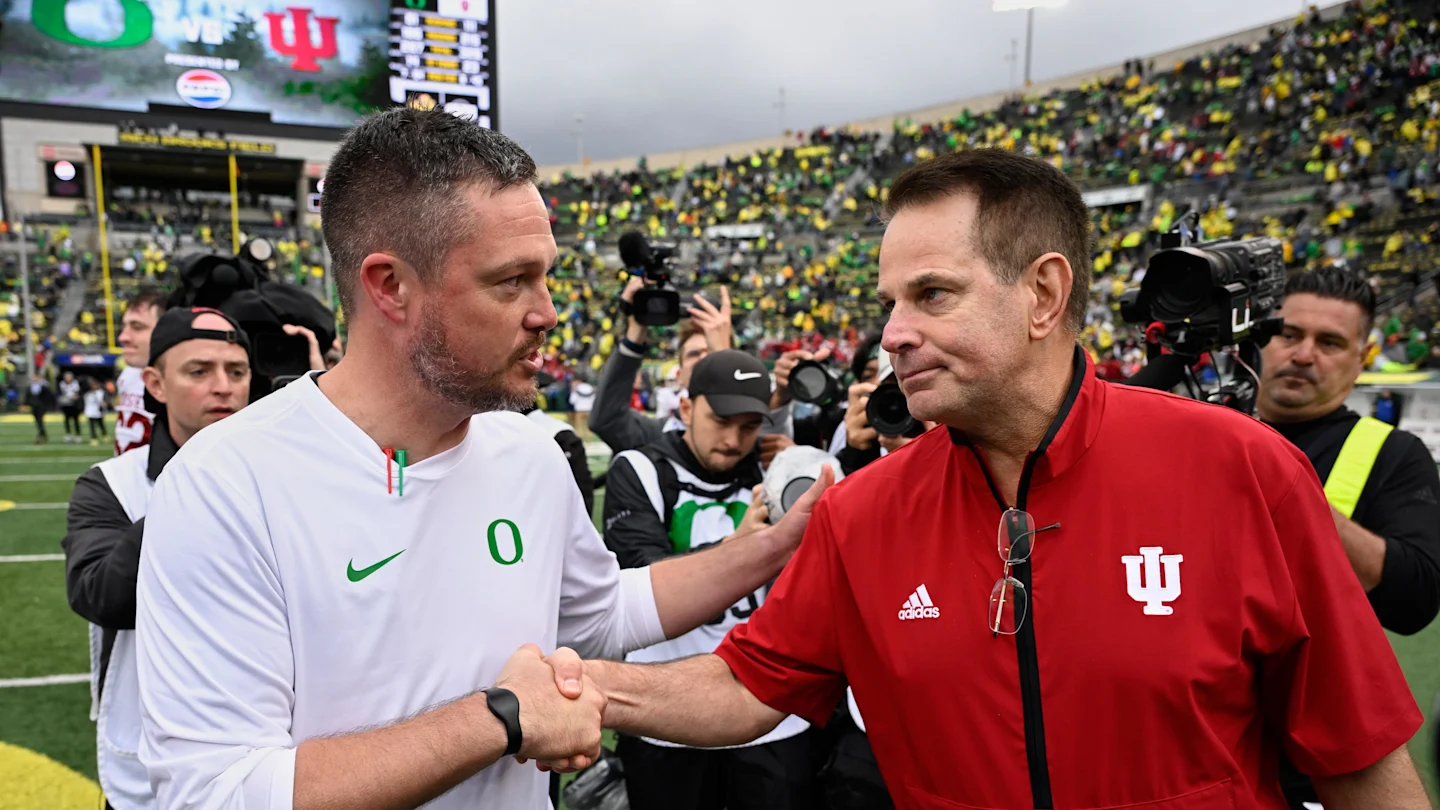
The College Football Playoff bracket is officially set, and this year’s slate could be one of the most thrilling in recent memory as teams fight for a chance to claim the 2025-26 National Championship.
Several programs have a real opportunity to win their first-ever national title, including the top-ranked Indiana Hoosiers, the No. 4 Texas Tech Raiders, and the No. 5 Oregon Ducks.

The Ducks will host a first-round playoff game at Autzen Stadium on Dec. 20 at 4:30 p.m. PT facing James Madison. The winner advances to face No. 4 seed Texas Tech in a quarterfinal game at the Orange Bowl on Jan. 1 at 9 a.m. PT in Miami, FL.
With dates, times, and matchups now locked in, the national title landscape is starting to shift. Oddsmakers have adjusted the odds, and fans are analyzing potential paths to the championship for each team.
National Championship Odds Shift
Despite Indiana beating Ohio State in the 2025 Big Ten Championship Game, oddsmakers still give the Buckeyes the best odds to win the national championship. If Ohio State does win, it will become the second FBS team to win back-to-back national titles in the College Football Playoff era, joining Georgia (2021, 2022.)
Indiana’s odds did get better, after the victory over Ohio State, moving from +450 to +300, while Ohio State’s dropped from +160 to +210.
Another big mover in title odds is the Texas A&M Aggies, who lost to the Texas Longhorns in their regular season finale and dropped from +1000 to now +1400 odds to win the title.
Oregon’s odds improved quite a bit, despite not playing this week from +1100 to +850. This could be in part due to an advantageous seed, opponent and home-field advantage. The Ducks have the fourth best odds to win the title in football.

Below are the updated odds on DraftKings to win the title.
Ohio State +210
Indiana +300
Georgia +600
Oregon +850
Texas Tech +800
Texas A&M +1400
Alabama +2000
Miami +2200
Ole Miss +2500
Oklahoma +6000
Notably, three out of the 10 teams with the best odds to win the national championship are in the Big Ten. Oregon’s opponent, James Madison is tied for the worst odds with Tulane at a massive +60000.
College Football Playoff Bracket

Here are the final rankings.
1. Indiana (Big Ten champion)
2. Ohio State
3. Georgia (SEC champion)
4. Texas Tech (Big 12 champion)
5. Oregon
6. Ole Miss
7. Texas A&M
8. Oklahoma
9. Alabama
10. Miami
11. Tulane (American Athletic champion)
12. James Madison (Sun Belt champion)
The College Football Playoff Selection Show talked about the Ducks.
“When is comes to Oregon, they know who they are. Dante Moore is playing outstanding. Kenyon Sadiq, best tight end in America. The physicality they exude. Another team that understands what their identity,” Booger McFarland said. “They haven’t always played up to their par throughout the season, but they’re starting to kick on all cylinders. And it’s going to be a tough ask for whoever has to go to Eugene and deal with the Ducks at Autzen.”

MORE: Five Things to Know About Oregon’s New Offensive Coordinator Drew Mehringer
MORE: Meet the Most Underrated Signees In Oregon’s Recruiting Class
MORE: Oregon’s Dan Lanning Reveals Recruitment of 5-Star Anthony Jones from Alabama
SIGN UP FOR OUR NEWSLETTER HERE!
Oregon’s high-powered offense and home-field advantage make them a team to watch, but the bracket is stacked with formidable opponents that could derail any contender. The Ducks cannot overlook their first round matchup as the Texas Tech Raiders wait in the quarterfinals round.
Here are the National Championship odds from Dec. 1, for reference.
Ohio State +160
Indiana +450
Georgia +800
Notre Dame +900
Texas A&M +1000
Texas Tech +1000
Oregon +1100
Alabama +1300
- Game odds refresh periodically and are subject to change.
- If you or someone you know has a gambling problem and wants help, call 1-800-GAMBLER.
NIL
Steady Droppin Dimes – NIL on National Signing Day: Is it all about the highest bidder now?

Every week, former Michigan great, NFL 1st round pick, 10-year pro, and current Wayne State head football coach Tyrone Wheatley, former Michigan point guard Daniel Horton, and I come together on Steady Droppin’ Dimes, a sports show featuring real talk, and real views, from three real dudes. College football, college basketball, NFL, and NBA topics drive much of the debate, but discussion of other sports will enter the fray some days as well. Non-sports topics aren’t off limits, and neither are celebrity guests.
On the latest episode of Steady Droppin Dimes, the crew discusses the impact of NIL on National Signing Day. They also tackle the question of which of the new college football hires has the best odds of success, and which will crash and burn. Lastly, they revisit the question of which is the best team in college basketball.
The contents and full episode notes appear below.
Contents and Episode Notes
00:00 – Opening, Holiday Catch-Up & Steady Dropping Dimes Crew
- Sam opens another edition of Steady Dropping Dimes, reintroducing the weekly show and its Golden Limo sponsorship
- He brings in the full crew, starting with Tyrone Wheatley, whom he still calls the best athlete he’s ever seen with his own eyes
- Tyrone shares he played last episode sick and reveals he actually had pneumonia but “toted the mail” anyway
- Sam jokes about producer Lance upgrading the show with color-coded scripts and name tags on screen
- Daniel Horton checks in, saying he barely made it to the show, and chat jokes about “in this NIL era, we steady dropping bags,” foreshadowing later NIL talk
05:22 – Daniel Flips: Michigan Is the Best Team in the Country
- Sam explains fans have been asking what’s up with Daniel, since Daniel wasn’t immediately crowning Michigan as the best team
- Daniel says at first everyone was just being “Michigan homers,” and he prides himself on not being a homer, even as an alum
- He now fully agrees Michigan is the best team in the country and playing the best basketball, especially on the defensive end
- Vegas convinced him: if they defend with that energy, effort, passion, and togetherness, he’ll “stand on the table” for this team
- Daniel stresses that shots won’t always fall or look pretty, but defense, effort, and love for what you’re doing translate in any game, in any sport
10:32 – Aday Mara’s Development, Consistency Questions & Dusty’s Roster Vision
- Sam shifts to the three-big frontcourt, saying Merez has surged lately and he didn’t expect Aday Mara to be this fluid at 7’3″
- He wonders how Mara will handle Big Ten physicality—opponents getting into his body, banging him, and forcing him to prove he can still rebound and score
- Sam notes Yax looks ready to bring it nightly, but he’s unsure whether Mara can sustain high-level play game-to-game after an early stretch where he looked like a lottery pick, then disappeared
- Daniel admits he was skeptical when Mara transferred after a disappointing UCLA stint, but says Mara’s progress this quickly is encouraging for his future
- He explains the hardest jump is from “not very good” to “serviceable/good,” and Mara seems to have cleared that; now it’s about experience and building consistency to become an all-conference-level player in Dusty’s system
13:34 – Transfer Fit, AJ Storr Example & Coach Responsibility
- Sam praises Dusty May’s ability to evaluate cultural fit in the transfer portal, calling it an elite skill in this era
- He contrasts Dusty’s approach with Chris Beard’s situation at Ole Miss, where Beard publicly snapped about effort at AJ Storr—who has now been at four schools in four years
- Sam says Beard was really mad at Storr for being who he has always been, pointing out Storr’s identity and track record were clear when they recruited him
- Tyrone says it’s on the coach and staff to know who they are bringing in and how each piece fits a defined role in the “11:30 p.m. staff room board” vision
- He notes great teams come from players majoring in their roles—big or small—and from coaches building rosters around those roles instead of blaming players later for being themselves
18:28 – Winning in the Margins, Toughness & Three-Big Philosophy
- Tyrone recalls his high school coach saying, “We’re going to win in the margins,” which meant two weeks of practice without a basketball focused on effort plays
- He sees Michigan’s current team doing exactly that: winning in the margins with turnovers forced, defense, pace, hype, rebounding, and extra effort that eventually turn into points
- He jokes that if his shot isn’t falling, he’ll “turn into Moses Malone,” attacking the offensive glass to keep impacting the game
- Sam contrasts John Beilein’s instinct—play Yax at the four—with Dusty’s willingness to lean into a three-big lineup, noting both views have logic but Dusty is the one staying up at midnight designing this vision
- Tyrone says different coaches prioritize different building blocks—some start with a big, some with a scorer—but Dusty’s big-heavy, physical, connected approach is working because the whole group fits the identity
21:18 – Dusty’s Transfer Strategy and Quick Chemistry in the Portal Era
- Sam circles back to Dusty’s eye for portal fits, saying he targets guys who fit Michigan’s culture first, then figures out how they fit on the court second
- Daniel points out that of the transfers, Yax was really the only one who had significant prior success; others like Elliott, Mara, and Namari came in as underused or underachieving pieces
- He credits Dusty for grabbing talented but hungry players who needed a stage and were motivated to prove they’re better than their previous roles showed
- Daniel says that in the old days, you built chemistry over 3–4 years; now, you must build it in one or two, and buy-in is easier when guys see this as a major or last chance
- He believes as long as Dusty keeps recruiting that mix of talent and hunger, Michigan can keep creating quick, genuine chemistry in modern one- and two-year windows
24:17 – Coaching Carousel Talk: Who Got It Right and Who Got It Wrong?
- Sam switches to college football, asking Daniel which recent coaching hires got it most right and most wrong
- Daniel surprisingly picks LSU for both: he sees Lane Kiffin as a home run given LSU’s resources and track record, but says the handling of the change from Brian Kelly was messy
- He also likes Jon Sumrall’s move to Florida (after tracking him at Tulane), noting his strong ties and upside as a head coach
- For “most wrong,” Daniel bluntly says it’s Penn State, because they fired their coach early yet still don’t have a replacement while other programs moved quickly
- Tyrone jokes that Crumble Cookie dropped a big NIL “dime” to help keep a coach put, illustrating how off-field money factors into these decisions too
28:02 – Lane at LSU, Complementary Football & Culture Fits
- Sam pushes back on the assumption that Kiffin will definitely win a national title at LSU, pointing out Lane has never truly “won anything big” at the highest level
- Tyrone counters that Lane’s time under Nick Saban taught him a lot, and he’ll build elite staffs and surround himself with the right people, which is how you win
- Daniel says Lane has rehabilitated his image since the Tennessee/USC days and that his confident, offensive-minded personality matches what LSU fans want more than Brian Kelly’s did
- Sam agrees LSU’s offense will be electric but questions whether Lane can sustain the kind of complementary football and elite defense required to win championships in the SEC
- They note Lane kept DC Blake Baker and has a massive NIL budget, but Tyrone warns the real challenge is using that money on the right players instead of simply stockpiling “convicts” with talent
32:58 – Michigan State, Pat Fitzgerald & Sparty’s Ceiling
- Sam pivots to a surprise take: he thinks Michigan State got it “most right” by hiring Pat Fitzgerald and jokes that MSU owes him money for saying months ago Fitz would rehabilitate them
- He paints a realistic model: at Northwestern, Fitzgerald accepted that they wouldn’t compete every year but would scrap for a few seasons and then build toward senior-heavy, competitive years every third or fourth season
- That cyclical, blue-collar approach fits Michigan State more than chasing the same recruits as Michigan and Ohio State, which Sam says “just isn’t them”
- Daniel laughs that Sam is diabolical, basically sentencing MSU to seven wins a year and one win over Michigan every five years and calling that their ceiling
- Sam leans into the bit, saying he’s giving Spartans a more honest reality than they want: they’re the “bootleg Lion-O,” not the real powerhouse, but Fitzgerald can make them respectable and occasionally dangerous
39:55 – Penn State Expectations, Fit, and the Stress of Big Jobs
- Sam and Tyrone agree LSU and Penn State both show how fanbases overestimate how “sexy” their jobs are compared to the stress and expectations
- Tyrone says some jobs are actually unattractive behind the scenes—LSU’s Bayou grind and Penn State’s national-title expectations without SEC-level resources limit the candidate pool
- He believes James Franklin got stale but also notes seven wins won’t cut it at Penn State, and coaches are now scrutinizing whether the financial and support package matches the stress level
- They argue that firing a coach isn’t a magic reset button—schools often discover the market isn’t beating down their door the way fans imagined
- Tyrone suggests Penn State might be best served hiring the interim (Terry Smith/Kenny W.), someone who already knows the realities, rather than chasing a fantasy candidate
46:17 – Savion Hiter, NIL Ambassadors & Setting Up the Signing Day Conversation
- Sam says they’d be remiss not to talk about National Signing Day and highlights No. 1 running back Savion Hiter signing with Michigan
- Listeners have asked for a weekly Hiter film breakdown from Tyrone, but Sam wants to give Tyrone time to watch tape before putting him on the spot
- He frames today’s focus as NIL’s impact on Signing Day itself, not just recruiting months beforehand
- Sam describes the day as “almost like day trading,” with schools sliding in last minute with extra $200–300K just as kids are ready to sign
- He stresses that for many families, that amount of money is life-altering, and taking time to consider it is not a character flaw—it’s a real-life decision
53:58 – NIL on Signing Day: Day-Trading Offers, Agents & Tough Choices
- Sam says some programs still take a “This is Michigan, this is the offer, take it or leave it” stance that implicitly shames families for considering better financial deals
- He has a major problem with using “character” language against kids—especially those from modest backgrounds—who weigh a significantly higher NIL number
- Sam explains another layer: agents now sit between players and schools, some being fully certified NFL agents already eyeing future pro commissions
- He lays out a hypothetical: a recruit committed to Michigan is offered $300K more by Penn State; the player wants Michigan, asks if Michigan can come up some, but his agent keeps pressuring him to take the higher Penn State offer
- Tyrone says this creates a painful squeeze: schools can be rigid and pompous on one side, agents self-interested on the other, and the kid in the middle just wants to make the right choice for school and family
59:20 – Negotiation, Family Stories & Why Money Doesn’t Equal Bad Character
- Tyrone’s wife once commented, “This is what they chose,” meaning once NIL got opened, the chaos was inevitable; you can’t un-open the box
- He argues players don’t actually need agents for most NIL agreements and wonders why someone should get 3–5% of money they didn’t earn on the field
- Tyrone calls much of the current agent behavior predatory and believes there should be a “true dead period” around signing day with total radio silence from schools
- He emphasizes that for many families, $300K represents “300,000 opportunities”—to pay off a mortgage, fix a car, avoid foreclosure, or get stability, not greed
- Tyrone shares a personal story of his grandmother turning down an illegal under-the-table offer back in the day; if the same money were legal NIL today, he’d absolutely negotiate hard to take care of her without that being a “character issue”
1:07:25 – Can NIL Be Regulated? Agents, Salary Sheets & Player Power
- Sam floats the idea that college football should proactively regulate NIL agents—perhaps through a player association or new legal framework—so families have access to vetted, accredited representatives
- Tyrone likes the idea in theory but asks who would regulate it, since the NCAA and schools both want to avoid added legal liability
- He suggests an alternative: a public “salary sheet” by position, similar to NFL structures, where schools must declare NIL ranges so players can see going rates without middlemen
- That kind of transparency would let a recruit compare three schools on signing day, open negotiations at 2:00 p.m., decide by 3:00, and skip paying an agent to shuttle numbers back and forth
- Both acknowledge agents can provide knowledge, but in the current unregulated environment too many chase quick fees and push kids toward the highest bid rather than the best overall decision for the player
1:14:09 – From Fax Machines to NIL Chaos, Brady Marchese vs. Zion & Closing
- Tyrone reminisces about the old signing-day stress being about NLIs arriving by fax and coaches camping at houses to flip kids, contrasting that with today’s last-minute NIL calls
- Sam says signing day used to be a celebration where coaches put their feet up; now it’s the most stressful day of the year, with staff sweating over possible late flips
- They joke about coaches like Fran Brown publicly threatening retaliation against those who try to flip their commits, hinting at how emotional the new market has become
- Sam closes by comparing WR Brady Marchese and Zion Robinson: Brady is a 6-1 burner and precision route runner who can return kicks and work the slot, while Zion is a longer 6-3 high-jumper type on the outside
- He says Brady’s top-end speed and versatility make him a great complement to Travis Johnson and Jamar Browder, fitting a different profile than Zion and rounding out the receiver room
- Sam wraps the episode thanking Golden Limo, the Dimes crew, and the audience, joking that he’s missing the Lions game for them and promising to be back next week with more film and NIL talk
1:18:22 – End of show
Not a VIP subscriber to The Michigan Insider? Sign up now and get access to everything TMI has to offer on all things Michigan and access to the No. 1 site covering the Wolverines for 60% an annual subscription!
Want the latest news on Michigan delivered right to your email? Subscribe to The Michigan Insider newsletter here. It is free and a great way to get daily updates on Michigan football, basketball, baseball, recruiting, and more delivered straight to your inbox.
Sign up for FREE text alerts on The Michigan Insider to get breaking news on commitments, decommitments, transfers, injuries, coaching changes, and more with our NEW text alert system available to all registered users and VIP subscribers. Click here to become a FREE registered user and Click here if you are already a VIP subscriber then follow these directions to set up your text alerts.
-

 Rec Sports2 weeks ago
Rec Sports2 weeks agoFirst Tee Winter Registration is open
-

 Rec Sports2 weeks ago
Rec Sports2 weeks agoFargo girl, 13, dies after collapsing during school basketball game – Grand Forks Herald
-

 Motorsports2 weeks ago
Motorsports2 weeks agoCPG Brands Like Allegra Are Betting on F1 for the First Time
-

 Sports3 weeks ago
Sports3 weeks agoVolleyball Recaps – November 18
-

 Motorsports2 weeks ago
Motorsports2 weeks agoF1 Las Vegas: Verstappen win, Norris and Piastri DQ tighten 2025 title fight
-

 Sports2 weeks ago
Sports2 weeks agoTwo Pro Volleyball Leagues Serve Up Plans for Minnesota Teams
-

 Sports2 weeks ago
Sports2 weeks agoUtah State Announces 2025-26 Indoor Track & Field Schedule
-

 Sports2 weeks ago
Sports2 weeks agoSycamores unveil 2026 track and field schedule
-

 Motorsports2 weeks ago
Motorsports2 weeks agoRedemption Means First Pro Stock World Championship for Dallas Glenn
-

 Sports2 weeks ago
Sports2 weeks agoTexas volleyball vs Kentucky game score: Live SEC tournament updates























































